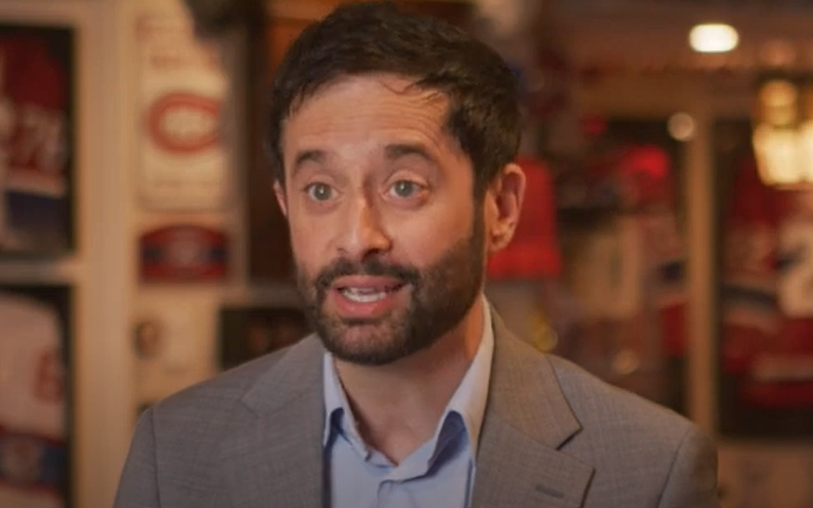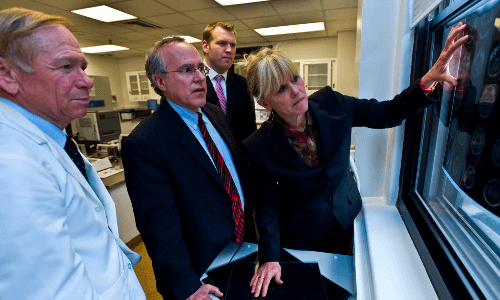What is CTE?
Chronic Traumatic Encephalopathy is a degenerative brain disease found in athletes, military veterans, and others with a history of repetitive brain trauma.

What is CTE?
According to the Boston University CTE Center, Chronic Traumatic Encephalopathy (CTE) is a degenerative brain disease found in athletes, military veterans, and others with a history of repetitive brain trauma. CTE is caused in part by repeated traumatic brain injuries, which include concussions and nonconcussive impacts. In CTE, experts believe a structural protein in neurons called tau misfolds and malfunctions, causes adjacent proteins to misfold, and sets off a chain reaction where this malfunctioning tau slowly spreads throughout the brain, killing brain cells. Right now, CTE can only be definitively diagnosed by autopsy after death. CTE has been diagnosed in people who died as young as 17, but symptoms do not generally begin appearing until years after the onset of head impacts. Most of what we have learned about CTE has come from the research of Dr. Ann McKee, director of the UNITE Brain Bank at Boston University. CLF co-founded the UNITE Brain Bank in 2008 and remains a collaborator on education and advocacy.
A brief history of CTE
CTE was first described in 1928, when Dr. Harrison Martland characterized a group of boxers as having “punch drunk syndrome.” Over the next 75 years, several researchers reported similar findings in boxers and other victims of brain trauma, but fewer than 50 cases were confirmed. In 2005, pathologist Dr. Bennet Omalu published the first evidence of CTE in an American football player: former Pittsburgh Steeler Mike Webster.
The publication caught the attention of CLF co-founder Dr. Chris Nowinski, who envisioned the world’s first athlete brain bank. Nowinski began reaching out to the families of former NFL players and other athletes who had recently passed away to arrange brain donations. He and Dr. Robert Cantu soon founded the Concussion Legacy Foundation and partnered with Boston University and the U.S. Department of Veterans Affairs to form the UNITE Brain Bank, which has now studied the brains of more than 1,300 athletes and veterans.
In the UK, we are proud to collaborate with Dr. Gabriele De Luca at the University of Oxford. Dr. De Luca leads the Concussion Legacy Project, a brain bank to study elite athletes and veterans with a history of repetitive head impacts and traumatic brain injury.
Symptoms of CTE

Mood and behavior symptoms
Among individuals diagnosed with CTE, some report mood and behaviour symptoms that can appear as early as the patient’s 20s. Disorders reported include:
- Impulse control problems
- Aggression
- Mood swings
- Depression
- Paranoia
- Anxiety
However, these reported symptoms may not necessarily be caused by CTE. Experts believe these symptoms could also be caused by concussions, other consequences of repetitive head impacts like white matter changes – or could be completely unrelated to head impacts.
No matter the cause, these symptoms can be treated, and the CLF HelpLine is here to connect you with a doctor who can help treat these symptoms and provide additional support.

Cognitive symptoms
Most patients with CTE eventually experience progressive disorders of thinking and memory, including problems with:
- Executive function
- Impaired judgment
- Short-term memory
- Dementia
Progressive cognitive symptoms related to CTE tend to appear later in life, sometimes in midlife, but more frequently in a patient’s 60s or 70s. Patients may exhibit one or both symptom clusters. In some cases, symptoms worsen with time (even if the patient suffers no additional head impacts). In other cases, symptoms may be stable for years before worsening.
If cognitive symptoms appear in early or midlife, they could have another, more treatable cause than CTE. Sleep disorders and neuroendocrine disorders from damage to the pituitary gland can cause treatable cognitive changes.

Sleep symptoms
A 2020 study from the UNITE Brain Bank suggests that problems with sleep, specifically symptoms associated with REM behaviour disorder, may be related to CTE pathology. Watch the study’s corresponding author describe the findings by clicking here.
However, treatable disorders like obstructive sleep apnoea, which is more likely to occur in contact sport athletes, can also cause cognitive symptoms.
Learn more about the role of sleep as it relates to CTE from Nathan Howarth.

What causes CTE?
CTE is caused in part by repeated traumatic brain injuries, which include concussions and nonconcussive impacts. This does not mean a handful of concussions, in the absence of other hits to the head, puts you at risk for CTE; most people diagnosed with CTE suffered hundreds or thousands of head impacts over the course of many years playing contact sports, serving in the military, or, more rarely, as victims of interpersonal violence.
The causal relationship was explored thoroughly in in the 2022 article Applying the Bradford Hill Criteria for Causation to Repetitive Head Impacts and CTE, published in Frontiers in Neurology. The article was authored by CLF’s Dr. Chris Nowinski, Dr. Robert Cantu, Dr. Samantha Bureau, and 11 other collaborators from around the world. The authors concluded with the highest confidence that repetitive head impacts (RHI) are the definitive cause of CTE.
In October 2022, The National Institute Neurological Disorders and Stroke (NINDS), part of the United States National Institutes of Health (NIH), formally acknowledged publicly that CTE is caused by repetitive traumatic brain injuries, after CLF sent a letter cosigned by 41 of the world’s top experts on CTE and related areas of science, urging them to review the current evidence outlined the Bradford Hill article. The NINDS joined the US Centers for Disease Control and Prevention in recognizing CTE is caused by repeated traumatic brain injuries.
Who is most at risk for CTE?
The UNITE Brain Bank has revolutionized how we understand CTE. More than 1,000 brains have been donated, teaching us who is at risk and how the disease manifests differently in different people. Our 1,000 Reasons for Hope report shows how the first 1,000 Legacy Donors are mapping the future of brain trauma research.

The report also shows that almost every person diagnosed with CTE has one thing in common: a history of repetitive hits to the head. CTE is most frequently found in contact sport athletes and military veterans. CTE has been found in individuals whose primary exposure to head impacts was through tackle football (700+ cases confirmed at the UNITE Brain Bank), the military (66+ cases), hockey (45+ cases), boxing (30+ cases, 50+ globally), rugby (18+ cases), soccer (24+ cases), amateur wrestling (15+ cases), and, in fewer than three cases each, baseball, basketball, intimate partner violence, and individuals with developmental disorders who engaged in head banging behaviors.
In 2023, the UNITE Brain Bank released that 345 of the first 376 NFL players studied were diagnosed with CTE, while only 1 in 164 subjects in the Framingham Heart Study had CTE, and the lone case was a former college football player.
Importantly, not everyone who has suffered repetitive hits to the head will develop CTE. There are several risk factors at play that make some people more prone to develop CTE than others, including the age of first exposure to head impacts, the number of years of exposure, and genetics.
Frequently Asked Questions
Treatments have not yet been developed to specifically treat CTE, BUT many of the symptoms of the disease can be treated. It’s important to know there is hope if you think you or a loved one may be living with CTE. Check out our CTE Treatments page to learn more.
Currently, CTE can only be diagnosed after death through brain tissue analysis. Doctors with a specialty in brain diseases slice brain tissue and use special chemicals to make the abnormal tau protein visible. They then systematically search areas of the brain for tau in the unique pattern specific to CTE. The process can take several months to complete, and the analysis is not typically performed as a part of a normal autopsy. In fact, until recently there were relatively few doctors who knew how to diagnose CTE.
In 2015, researchers from the UNITE Brain Bank, led by Dr. Ann McKee, collaborated with the National Institutes of Health to develop diagnostic criteria for CTE so that any neuropathologist familiar with brain diseases can accurately diagnose CTE. This important work has made it possible for more and more scientists to be on the lookout for CTE, helping accelerate progress.

